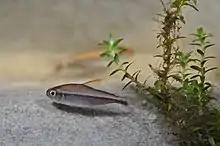| Hyphessobrycon agulha | |
|---|---|
 | |
| Scientific classification | |
| Domain: | Eukaryota |
| Kingdom: | Animalia |
| Phylum: | Chordata |
| Class: | Actinopterygii |
| Order: | Characiformes |
| Family: | Characidae |
| Genus: | Hyphessobrycon |
| Species: | H. agulha |
| Binomial name | |
| Hyphessobrycon agulha (Fowler, 1913) | |
Hyphessobrycon agulha (also known as the red-tailed flag tetra) is a species of tetra in the family Characidae. As a freshwater fish, it inhabits the basin of the Madeira River in Brazil along with parts of Peru and Bolivia, and it reaches a maximum length of 4.3 centimetres (1.7 in).[2] Though it is mainly found in the wild, it is occasionally kept by fishkeepers[3] and is sometimes confused with the neon tetra.[4] The fish is primarily an insectivore, though it does eat vegetable matter.[5] It is considered to form a group with other species in Hyphessobrycon as they share a dark stripe running lengthwise.[6]
While its name comes from the native name for this species along the Madeira River in Brazil,[7] the fish also occurs in Colombia and Peru.
References
- ↑ Lima, F. (2023). "Hyphessobrycon agulha". IUCN Red List of Threatened Species. 2023: e.T49829494A159672113. doi:10.2305/IUCN.UK.2023-1.RLTS.T49829494A159672113.en. Retrieved 27 December 2023.
- ↑ Froese, Rainer; Pauly, Daniel (eds.) (2017). "Hyphessobrycon agulha" in FishBase. November 2017 version.
- ↑ "Hyphessobrycon agulha - Fowler, 1913". Seriously Fish. 2017. Retrieved 25 November 2017.
- ↑ Axelrod, N.H.; Emmens, C.W.; Sculthorpe, D.; Vorderwinkler, W.; Pronek, N. (1962). Exotic Tropical Fishes. Sterling Publishing Company.
- ↑ Cyrino, J.E.P (10 January 2008). Feeding and Digestive Functions in Fishes. Boca Raton: CRC Press. p. 17. ISBN 9781439842690.
- ↑ Ho, Leonard (14 April 2017). "A new tetra fish from Columbia". Advanced Aquarist. Pomacanthus Publications. Archived from the original on 1 December 2017. Retrieved 26 November 2017.
- ↑ Christopher Scharpf & Kenneth J. Lazara. "Family CHARACIDAE: Subfamily STETHAPRIONINAE Eigenmann 1907 (American Tetras)". The ETYFish Project Fish Name Etymology Database. Christopher Scharpf and Kenneth J. Lazara. Retrieved 27 December 2023.
